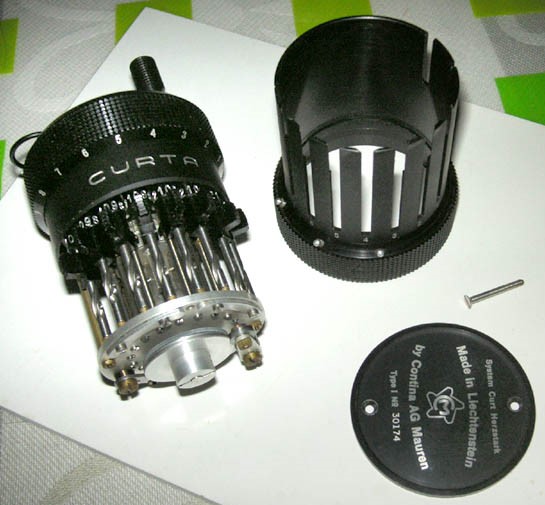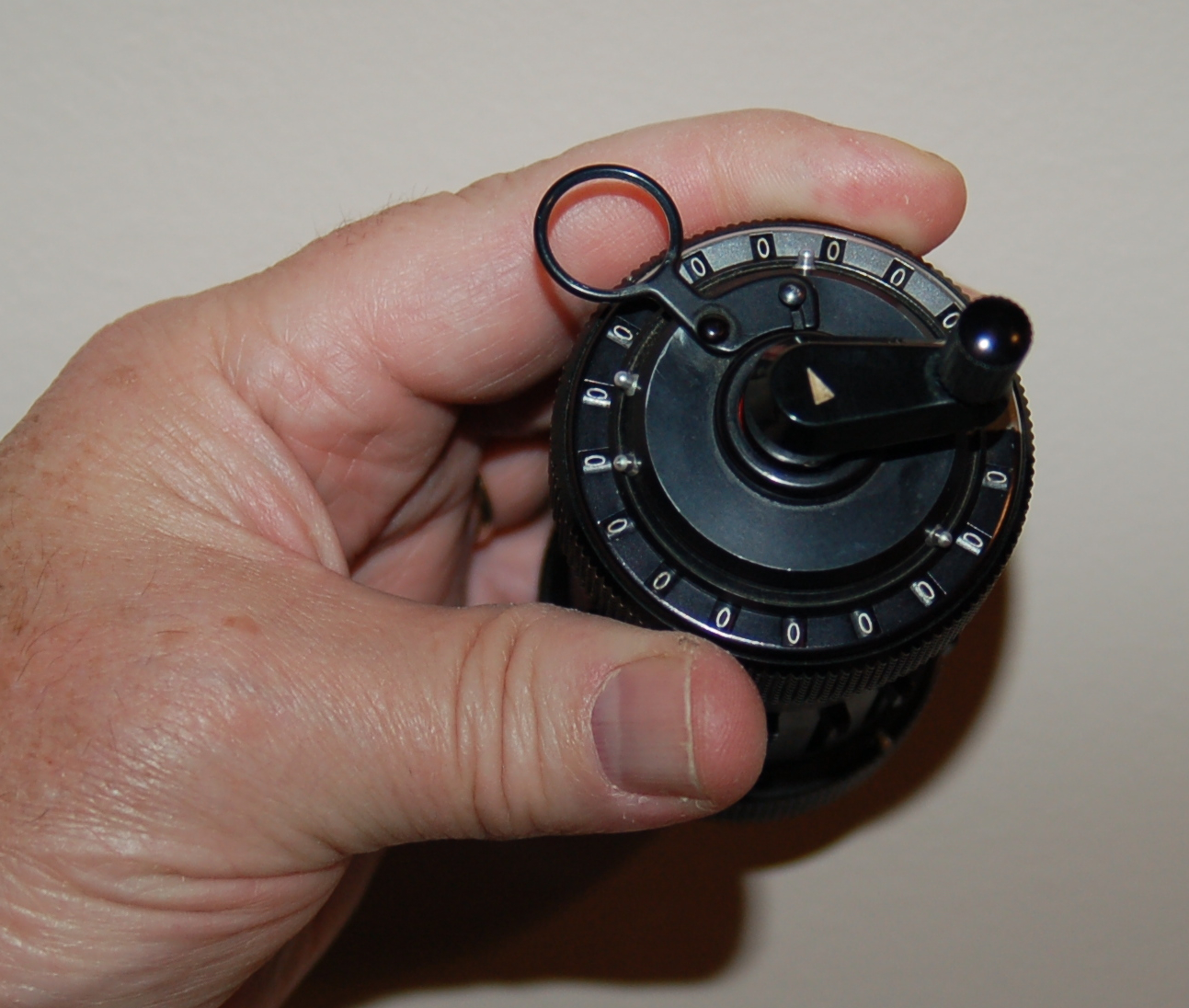Curta on:
[Wikipedia]
[Google]
[Amazon]



 The Curta is a hand-held
The Curta is a hand-held
/ref> The machines have a high curiosity value; in 2016 they sold for around US$1,000, but buyers paid as much as US$1,900 for models in pristine condition with notable serial numbers.
 The Curta plays a role in
The Curta plays a role in
on
Curta I
Vintage Calculators Web Museum: Mechanical Calculators
Curta.org
Video on internal workings of the Curta by MechanicalComputing
Many resources
http://www.curta.ch
Information about Curta / Video about the assembly of a Curta / Book about Curt Herzstark (Kein Geschenk für den Führer - Schicksal eines begnadeten Erfinders)
curta.li: model history, user and service manuals, parts photos, blueprints, etc.
Type and Age of your Curta
Files to 3D print a 3:1 scale model of a Curta
Curta.fr
Mainly focused on maintenance, repair and support. In french. * * {{Calculator navbox Computer-related introductions in 1948 1948 in Austria Mechanical calculators Austrian inventions


mechanical calculator
A mechanical calculator, or calculating machine, is a mechanical device used to perform the basic operations of arithmetic automatically, or a simulation like an analog computer or a slide rule. Most mechanical calculators were comparable in si ...
designed by Curt Herzstark. It is known for its extremely compact design: a small cylinder that fits in the palm of the hand. It was affectionately known as the "pepper grinder" or "peppermill" due to its shape and means of operation; its superficial resemblance to a certain type of hand grenade
A grenade is a small explosive weapon typically thrown by hand (also called hand grenade), but can also refer to a Shell (projectile), shell (explosive projectile) shot from the muzzle of a rifle (as a rifle grenade) or a grenade launcher. A mod ...
also earned it the nickname "math grenade".
Curtas were considered the best portable calculators available until they were displaced by electronic calculators in the 1970s.
History
The Curta was conceived by Curt Herzstark in the 1930s inVienna
Vienna ( ; ; ) is the capital city, capital, List of largest cities in Austria, most populous city, and one of Federal states of Austria, nine federal states of Austria. It is Austria's primate city, with just over two million inhabitants. ...
, Austria
Austria, formally the Republic of Austria, is a landlocked country in Central Europe, lying in the Eastern Alps. It is a federation of nine Federal states of Austria, states, of which the capital Vienna is the List of largest cities in Aust ...
. By 1938, he had filed a key patent, covering his complemented stepped drum. This single drum replaced the multiple drums, typically around 10 or so, of contemporary calculators, and it enabled not only addition, but subtraction through nines complement math, essentially subtracting by adding. The nines' complement math breakthrough eliminated the significant mechanical complexity created when "borrowing" during subtraction. This drum was the key to miniaturizing the Curta.
His work on the pocket calculator stopped in 1938 when the Nazi
Nazism (), formally named National Socialism (NS; , ), is the far-right politics, far-right Totalitarianism, totalitarian socio-political ideology and practices associated with Adolf Hitler and the Nazi Party (NSDAP) in Germany. During H ...
s forced him and his company to concentrate on manufacturing precision instruments for the German army.
Herzstark, the son of a Catholic mother and Jewish father, was taken into custody in 1943 and eventually sent to Buchenwald concentration camp
Buchenwald (; 'beech forest') was a German Nazi concentration camp established on Ettersberg hill near Weimar, Nazi Germany, Germany, in July 1937. It was one of the first and the largest of the concentration camps within the Altreich (pre-1938 ...
, where he was encouraged to continue his earlier research:
In the camp, Herzstark was able to develop working drawings for a manufacturable device. Buchenwald was liberated by U.S. troops on 11 April 1945, and by November Herzstark had located a factory in Sommertal, near Weimar
Weimar is a city in the state (Germany), German state of Thuringia, in Central Germany (cultural area), Central Germany between Erfurt to the west and Jena to the east, southwest of Leipzig, north of Nuremberg and west of Dresden. Together w ...
, whose machinists were skilled enough to produce three working prototypes.
Soviet
The Union of Soviet Socialist Republics. (USSR), commonly known as the Soviet Union, was a List of former transcontinental countries#Since 1700, transcontinental country that spanned much of Eurasia from 1922 until Dissolution of the Soviet ...
forces had arrived in July, and Herzstark feared being sent to Russia, so, later that same month, he fled to Austria. He began to look for financial backers, at the same time filing continuing patents as well as several additional patents to protect his work. Franz Joseph II, Prince of Liechtenstein
Franz Joseph II (Franz Josef Maria Alois Alfred Karl Johannes Heinrich Michael Georg Ignaz Benediktus Gerhardus Majella; 16 August 1906 – 13 November 1989) was the reigning Monarchy of Liechtenstein, Prince of Liechtenstein from 25 July 1938 u ...
eventually showed interest in the manufacture of the device, and soon a newly formed company, Contina AG Mauren, began production in Liechtenstein.
It was not long before Herzstark's financial backers, thinking they had got from him all they needed, conspired to force him out by reducing the value of all of the company's existing stock to zero, including his one-third interest. These were the same people who had earlier elected not to have Herzstark transfer ownership of his patents to the company, so that, should anyone sue, they would be suing Herzstark, not the company, thereby protecting themselves at Herzstark's expense. This ploy now backfired: without the patent rights, they could manufacture nothing. Herzstark was able to negotiate a new agreement, and money continued to flow to him.
Curtas were considered the best portable calculators available until they were displaced by electronic calculators in the 1970s. The Curta, however, lives on, being a highly popular collectible, with thousands of machines working just as smoothly as they did at the time of their manufacture.
An estimated 140,000 Curta calculators were made (80,000 Type I and 60,000 Type II). According to Curt Herzstark, the last Curta was produced in 1972.
Cost
The Curta Type I was sold for $125 in the later years of production, and the Type II was sold for $175. While only 3% of Curtas were returned to the factory for warranty repair, a small, but significant number of buyers returned their Curtas in pieces, having attempted to disassemble them. Reassembling the machine was more difficult, requiring intimate knowledge of the orientation of, and installation order for, each part and sub-assembly, plus special guides designed to hold the pieces in place during assembly. Many identical-looking parts, each with slightly different dimensions, required test fitting and selection as well as special tools to adjust to design tolerances.Several specialized Curta tools pictured at curta.li/ref> The machines have a high curiosity value; in 2016 they sold for around US$1,000, but buyers paid as much as US$1,900 for models in pristine condition with notable serial numbers.
Design
The Curta's design is a descendant ofGottfried Leibniz
Gottfried Wilhelm Leibniz (or Leibnitz; – 14 November 1716) was a German polymath active as a mathematician, philosopher, scientist and diplomat who is credited, alongside Isaac Newton, Sir Isaac Newton, with the creation of calculus in ad ...
's Stepped Reckoner and Charles Thomas's Arithmometer
The arithmometer () was the first digital data, digital mechanical calculator strong and reliable enough to be used daily in an office environment. This calculator could add and subtract two numbers directly and perform Multiplication algorithm, ...
, accumulating values on cogs, which are added or complemented by a stepped drum mechanism.
Numbers are entered using slides (one slide per digit) on the side of the device. The ''revolution counter'' and ''result counter'' reside around the shiftable carriage, at the top of the machine. A single turn of the crank adds the input number to the result counter, at any carriage position, and increments the corresponding digit of the revolution counter. Pulling the crank upwards slightly before turning performs a subtraction instead of an addition. Multiplication, division, and other functions require a series of crank and carriage-shifting operations.
Models
The Type I Curta has eight digits for data entry (known as "setting sliders"), a six-digit revolution counter, and an eleven-digit result counter. According to the advertising literature, it weighs only . Serial number 70154, produced in 1969, weighs . The larger Type II Curta, introduced in 1954, has eleven digits for data entry, an eight-digit revolution counter, and a fifteen-digit result counter.Uses
The Curta was popular among contestants in sports car rallies during the 1960s, 1970s and into the 1980s. Even after the introduction of the electronic calculator for other purposes, they were used in time-speed-distance (TSD) rallies to aid in computation of times to checkpoints, distances off-course and so on, since the early electronic calculators did not fare well with the bounces and jolts of rallying. The Curta was also favored by commercial and general-aviation pilots before the advent of electronic calculators because of its precision and the user's ability to confirm the accuracy of their manipulations via the revolution counter. Because calculations such as weight and balance are critical for safe flight, precise results free of pilot error are essential.Collections
The Curta calculator is very popular among collectors and can be purchased on many platforms. The Swiss entrepreneur and collector Peter Regenass holds a large collection of mechanical calculators, among them over 100 Curta calculators. A part of his collections is on display at the Enter Museum inSolothurn
Solothurn ( ; ; ; ; ) is a town, a municipality, and the capital of the canton of Solothurn in Switzerland. It is located in the north-west of Switzerland on the banks of the Aare and on the foot of the Weissenstein Jura mountains.
The town is ...
, Switzerland. In 2016 he donated a Curta calculator to the Yad Vashem
Yad Vashem (; ) is Israel's official memorial institution to the victims of Holocaust, the Holocaust known in Hebrew language, Hebrew as the (). It is dedicated to preserving the memory of the Jews who were murdered; echoing the stories of the ...
Museum in Jerusalem.
Popular culture
 The Curta plays a role in
The Curta plays a role in William Gibson
William Ford Gibson (born March 17, 1948) is an American-Canadian speculative fiction writer and essayist widely credited with pioneering the science fiction subgenre known as cyberpunk. Beginning his writing career in the late 1970s, his ear ...
's ''Pattern Recognition'' (2003) as a piece of historic computing machinery as well as a crucial "trade" item.
In 2016 a Curta was designed by Marcus Wu that could be produced on a 3D printer. The 3D-Printed Curta Calculatoron
Thingiverse
Thingiverse is a website dedicated to the sharing of user-created digital design files. Providing primarily free, open-source hardware designs licensed under the GNU General Public License or Creative Commons licenses, the site allows contributor ...
() The Curta's fine tolerances were beyond the ability of printer technology of 2017 to produce to scale, so the printed Curta was about the size of a coffee can and weighed about three pounds.
Further reading
* *References
External links
Curta I
Vintage Calculators Web Museum: Mechanical Calculators
Curta.org
Video on internal workings of the Curta by MechanicalComputing
Many resources
http://www.curta.ch
Information about Curta / Video about the assembly of a Curta / Book about Curt Herzstark (Kein Geschenk für den Führer - Schicksal eines begnadeten Erfinders)
curta.li: model history, user and service manuals, parts photos, blueprints, etc.
Type and Age of your Curta
Files to 3D print a 3:1 scale model of a Curta
Curta.fr
Mainly focused on maintenance, repair and support. In french. * * {{Calculator navbox Computer-related introductions in 1948 1948 in Austria Mechanical calculators Austrian inventions